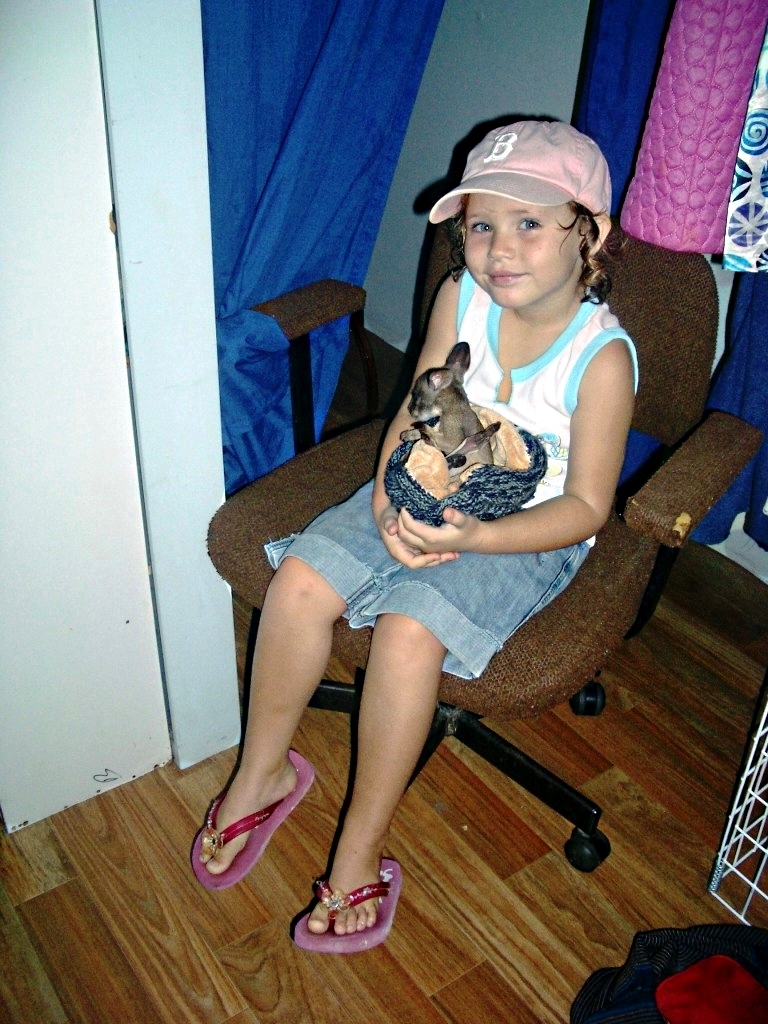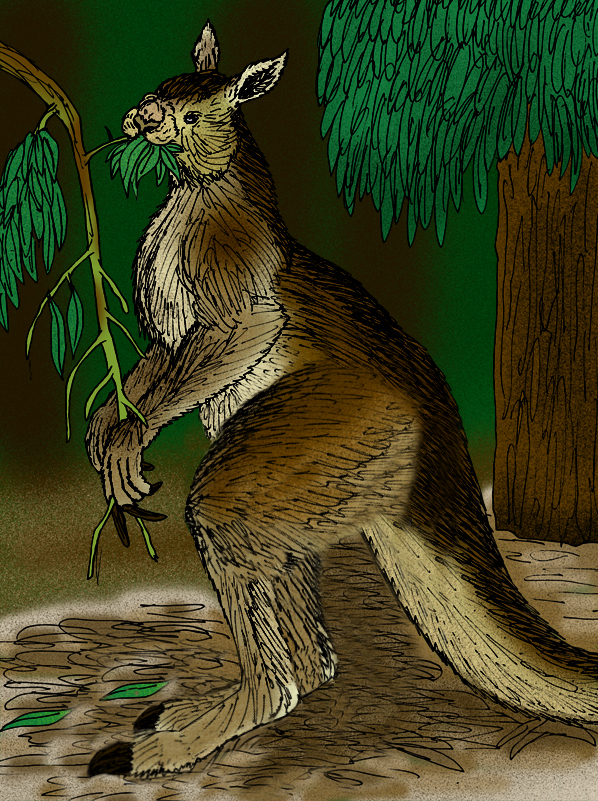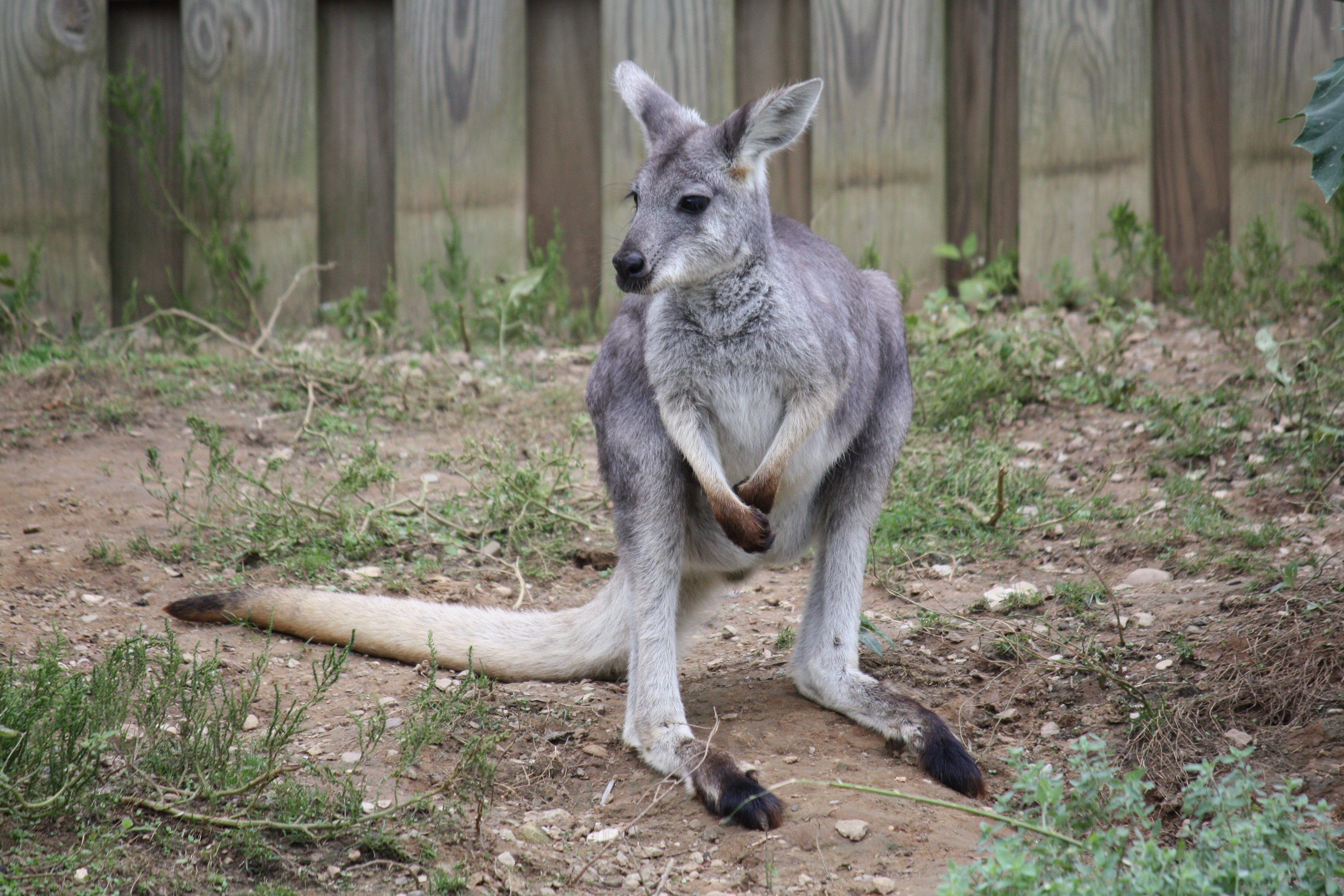|
Wallaby
A wallaby () is a small or middle-sized Macropodidae, macropod native to Australia and New Guinea, with introduced populations in New Zealand, Hawaii, the United Kingdom and other countries. They belong to the same Taxonomy (biology), taxonomic family as kangaroos and sometimes the same genus, but kangaroos are specifically categorised into the four largest species of the family. The term "wallaby" is an informal designation generally used for any macropod that is smaller than a kangaroo or a wallaroo that has not been designated otherwise. There are nine species (eight extant and one Extinction, extinct) of the brush wallaby (genus ''Notamacropus''). Their head and body length is and the tail is long. The 19 known species of Rock-wallaby, rock-wallabies (genus ''Petrogale'') live among rocks, usually near water; two species in this genus are endangered. The two living species of hare-wallabies (genus ''Lagorchestes''; two other species in this genus are extinct) are sma ... [...More Info...] [...Related Items...] OR: [Wikipedia] [Google] [Baidu] |
Notamacropus
''Notamacropus'' is a genus of small marsupials in the family Macropodidae, commonly known as wallabies (among other species). The term is derived from the Latin ''nota'' "stripe" and ''macropus'' "kangaroo", referencing the distinct facial stripe of many extant genus members and their phylogenetic relationship to other kangaroos. In 2019, a reassessment of macropod taxonomy determined that ''Notamacropus'' and ''Osphranter'', formerly considered subgenera of ''Macropus'', should be moved to the genus level. This change was accepted by the Australian Faunal Directory in 2020. Species References External links * Macropods Marsupials of Australia Marsupial genera Taxa named by Tim Flannery {{diprotodont-stub ... [...More Info...] [...Related Items...] OR: [Wikipedia] [Google] [Baidu] |
Agile Wallaby
The agile wallaby (''Notamacropus agilis''), also known as the sandy wallaby, is a species of wallaby found in northern Australia and southern New Guinea. It is the most common wallaby in north Australia. The agile wallaby is a sandy colour, becoming paler below. It is sometimes solitary and at other times sociable and grazes on grasses and other plants. The agile wallaby is not considered threatened. Subspecies The four subspecies of the agile wallaby are: *''N. a. agilis'', the nominate subspecies, is found in the Northern Territory. *''N. a. jardinii'' is found on the northern and eastern coasts of Queensland. *''N. a. nigrescens'' is found in the Kimberley and Arnhem Land regions of Western Australia. *''N. a. papuanus'' is found in southern New Guinea and some neighbouring islands. Description Male agile wallabies are considerably larger than females, having a head and body length of up to and weighing while the females grow to in length and weigh . The tails of both sex ... [...More Info...] [...Related Items...] OR: [Wikipedia] [Google] [Baidu] |
Swamp Wallaby
The swamp wallaby (''Wallabia bicolor'') is a small macropod marsupial of eastern Australia. This wallaby is also commonly known as the black wallaby, with other names including black-tailed wallaby, fern wallaby, black pademelon, stinker (in Queensland), and black stinker (in New South Wales) on account of its characteristic swampy odour. The swamp wallaby is the only living member of the genus ''Wallabia''. Etymology Historic names for the swamp wallaby include Aroe kangaroo. The swamp wallaby is known as ''banggarai'' in the Dharawal language. Habitat and distribution The swamp wallaby is found from the northernmost areas of Cape York Peninsula in Queensland, down the entire east coast and around to western Victoria and south-eastern South Australia, where it has greatly expanded its distribution over the past four decades. Advances in rabbit control appear to have resulted in extension of the swamp wallaby's distribution, which has expanded since the time of European sett ... [...More Info...] [...Related Items...] OR: [Wikipedia] [Google] [Baidu] |
Kangaroo
Kangaroos are marsupials from the family Macropodidae (macropods, meaning "large foot"). In common use, the term is used to describe the largest species from this family, the red kangaroo, as well as the antilopine kangaroo, eastern grey kangaroo, and western grey kangaroo. Kangaroos are indigenous to Australia and New Guinea. The Australian government estimates that 42.8 million kangaroos lived within the commercial harvest areas of Australia in 2019, down from 53.2 million in 2013. As with the terms " wallaroo" and "wallaby", "kangaroo" refers to a paraphyletic grouping of species. All three terms refer to members of the same taxonomic family, Macropodidae, and are distinguished according to size. The largest species in the family are called "kangaroos" and the smallest are generally called "wallabies". The term "wallaroos" refers to species of an intermediate size. There are also the tree-kangaroos, another type of macropod which inhabit the upper branches ... [...More Info...] [...Related Items...] OR: [Wikipedia] [Google] [Baidu] |
Macropodidae
Macropodidae is a Family (biology), family of marsupials that includes kangaroos, Wallaby, wallabies, tree-kangaroos, wallaroos, pademelons, quokkas, and several other groups. These genera are allied to the suborder Macropodiformes, containing other macropods, and are native to the Australia (continent), Australian continent (the mainland and Tasmania), New Guinea and nearby islands. Description Although Propleopus, omnivorous kangaroos lived in the past, these were not members of the family Macropodidae; modern macropods are generally Herbivore, herbivorous. Some are Browsing (herbivory), browsers, but most are Grazing, grazers and are equipped with appropriately specialised teeth for cropping and grinding up fibrous plants, in particular grasses and Cyperaceae, sedges. Modern omnivorous kangaroos generally belong to a different family (for example, the Musky rat-kangaroo). In general, macropods have a broad, straight row of cutting teeth at the front of the mouth, no Canine t ... [...More Info...] [...Related Items...] OR: [Wikipedia] [Google] [Baidu] |
Pademelon
Pademelons () are small marsupials in the genus ''Thylogale'', found in Australia, New Guinea, and surrounding islands. They are some of the smallest members of the macropod family, which includes the similar-looking but larger kangaroos and wallabies. Pademelons are distinguished by their small size and their short, thick, and sparsely haired tails. Like other marsupials, they carry their young in a pouch. Etymology The word "pademelon" comes from the word ''badimaliyan'' in Dharug, an Australian Aboriginal language spoken near what is now Port Jackson, New South Wales. The scientific name ''Thylogale'' uses the Greek words for "pouch" and "weasel." Description Along with the rock-wallabies and the hare-wallabies, the pademelons are among the smallest members of the macropod family. Mature male pademelons are larger than females, with an average weight of about 7 kg and height of 60 cm. Mature females weigh around 3.8 kg. Species There are seven recognise ... [...More Info...] [...Related Items...] OR: [Wikipedia] [Google] [Baidu] |
Lagorchestes
''Lagorchestes'' is a genus of small, rabbit-like mammals commonly known as hare-wallabies. It includes four species native to Australia and New Guinea, two of which are extinct. Hare-wallabies belong to the macropod family (Macropodidae) which includes kangaroos, wallabies, and other marsupials. Species It has four species, two of which are extinct: Extinct The oldest known fossil of ''Lagorchestes'' is an 11,000-year-old one of the extant Extant or Least-concern species, least concern is the opposite of the word extinct. It may refer to: * Extant hereditary titles * Extant literature, surviving literature, such as ''Beowulf'', the oldest extant manuscript written in English * Exta ... spectacled hare-wallaby. References External links * Macropods Marsupials of Australia Marsupial genera Taxa named by John Gould {{Diprotodont-stub ... [...More Info...] [...Related Items...] OR: [Wikipedia] [Google] [Baidu] |
Wallaroo
Wallaroo is a common name for several species of moderately large macropods, intermediate in size between the kangaroos and the wallabies, that are native to Australia and Papua New Guinea. The word "wallaroo" is from the Dharug ''walaru'' with spelling influenced by the words "kangaroo" and "wallaby". Description Wallaroos are typically distinct species from kangaroos and wallabies. An exception is the antilopine wallaroo, which is commonly known as an antilopine kangaroo when large, an antilopine wallaby when small, or an antilopine wallaroo when of intermediate size. Species Wallaroo may refer to one of several species in the genus ''Osphranter'': * The common wallaroo or wallaroo (''Osphranter robustus'') is the best-known species. There are four subspecies of the common wallaroo: the eastern wallaroo (''O. r. robustus'') and the euro (''O. r. erubescens''), which are both widespread, and two of more restricted range, one from Barrow Island (the Barrow Island wal ... [...More Info...] [...Related Items...] OR: [Wikipedia] [Google] [Baidu] |
Marsupial
Marsupials are a diverse group of mammals belonging to the infraclass Marsupialia. They are natively found in Australasia, Wallacea, and the Americas. One of marsupials' unique features is their reproductive strategy: the young are born in a relatively undeveloped state and then nurtured within a pouch on their mother's abdomen. Extant marsupials encompass many species, including Kangaroo, kangaroos, Koala, koalas, Opossum, opossums, Phalangeriformes, possums, Tasmanian devil, Tasmanian devils, Wombat, wombats, Wallaby, wallabies, and Bandicoot, bandicoots. Marsupials constitute a clade stemming from the last common ancestor of extant Metatheria, which encompasses all mammals more closely related to marsupials than to Placentalia, placentals. The evolutionary split between placentals and marsupials occurred 125-160 million years ago, in the Middle Jurassic-Early Cretaceous period. Presently, close to 70% of the 334 extant marsupial species are concentrated on the Australian ... [...More Info...] [...Related Items...] OR: [Wikipedia] [Google] [Baidu] |
Rock-wallaby
The rock-wallabies are the wallabies of the genus ''Petrogale''. Taxonomy The genus was established in 1837 by John Edward Gray in a revision of material at the British Museum of Natural History. Gray nominated his earlier description of ''Kangurus pencillatus'' as the type species, now recognised in the combination '' Petrogale penicillata'' (brush-tailed rock-wallaby). The author separated the species from the defunct genus ''Kangurus'', which he proposed to divide in his synopsis of the known macropod species. The following is a list of species, with common names, arranged by alliances of species groups: * Genus ''Petrogale'' ** ''P. brachyotis'' species group *** Short-eared rock-wallaby, ''Petrogale brachyotis'' *** Monjon, ''Petrogale burbidgei'' *** Nabarlek, ''Petrogale concinna'' *** Eastern short-eared rock-wallaby, ''Petrogale wilkinsi'' ** ''P. xanthopus'' species group *** Proserpine rock-wallaby, ''Petrogale persephone'' *** Rothschild's rock-wallaby, ''Pe ... [...More Info...] [...Related Items...] OR: [Wikipedia] [Google] [Baidu] |
Australia
Australia, officially the Commonwealth of Australia, is a country comprising mainland Australia, the mainland of the Australia (continent), Australian continent, the island of Tasmania and list of islands of Australia, numerous smaller islands. It has a total area of , making it the list of countries and dependencies by area, sixth-largest country in the world and the largest in Oceania. Australia is the world's flattest and driest inhabited continent. It is a megadiverse countries, megadiverse country, and its size gives it a wide variety of landscapes and Climate of Australia, climates including deserts of Australia, deserts in the Outback, interior and forests of Australia, tropical rainforests along the Eastern states of Australia, coast. The ancestors of Aboriginal Australians began arriving from south-east Asia 50,000 to 65,000 years ago, during the Last Glacial Period, last glacial period. By the time of British settlement, Aboriginal Australians spoke 250 distinct l ... [...More Info...] [...Related Items...] OR: [Wikipedia] [Google] [Baidu] |








